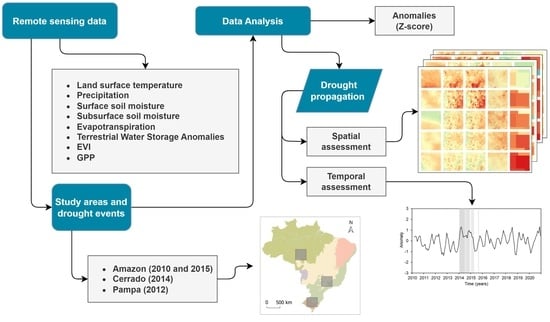Drought Propagation in Brazilian Biomes Revealed by Remote Sensing
Abstract
1. Introduction
2. Materials and Methods
2.1. Study Areas and Drought Events
2.1.1. Amazon: The 2010 and 2015 Droughts
2.1.2. Cerrado: The 2014 Drought
2.1.3. Pampa: The 2012 Drought
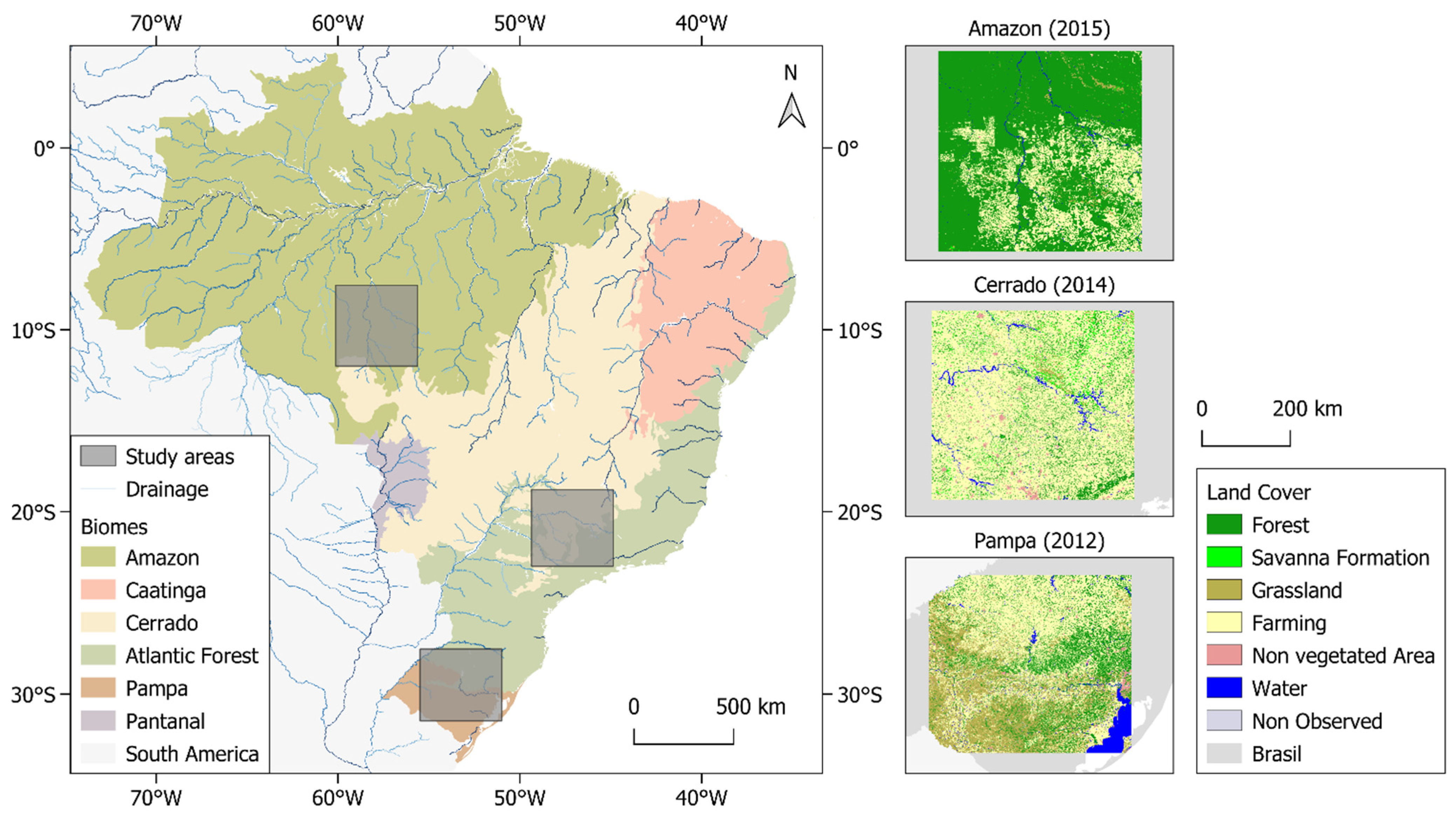
2.2. Datasets
2.2.1. Land Surface Temperature
2.2.2. Precipitation
2.2.3. Surface and Subsurface Soil Moisture
2.2.4. Evapotranspiration
2.2.5. Terrestrial Water Storage
2.2.6. Vegetation Index
2.2.7. Data Analysis
3. Results
3.1. Spatio-Temporal Drought Patterns
3.2. Drought Propagation Analysis
4. Discussion
5. Conclusions
Author Contributions
Funding
Data Availability Statement
Acknowledgments
Conflicts of Interest
References
- Hartmann, D.L.; Tank, A.M.G.K.; Rusticucci, M.; Alexander, L.; Brönnimann, S.; Charabi, Y.; Dentener, F.; Dlugokencky, E.; Easterling, D.; Kaplan, A.; et al. Observations: Atmosphere and Surface Supplementary Material. In Climate Change 2013 – The Physical Science Basis: Working Group I Contribution to the Fifth Assessment Report of the Intergovernmental Panel on Climate Change; Intergovernmental Panel on Climate Change: Geneva, Switzerland, 2013; pp. 159–254. [Google Scholar]
- Johnson, G.C.; Lyman, J.M. Warming Trends Increasingly Dominate Global Ocean. Nat. Clim. Chang. 2020, 10, 757–761. [Google Scholar] [CrossRef]
- Paul, V. Global Temperatures in 2020 Tied Record Highs. Science 2021, 371, 334–335. [Google Scholar] [CrossRef]
- Seneviratne, S.I.; Nicholls, N.; Easterling, D.; Goodess, C.M.; Kanae, S.; Kossin, J.; Luo, Y.; Marengo, J.; Mc Innes, K.; Rahimi, M.; et al. Changes in Climate Extremes and Their Impacts on the Natural Physical Environment. In Managing the Risks of Extreme Events and Disasters to Advance Climate Change Adaptation. A Special Report of Working Groups I and II of the Intergovernmental Panel on Climate Change (IPCC); Cambridge University Press: Cambridge, UK, 2012; pp. 109–230. [Google Scholar] [CrossRef]
- Perkins-Kirkpatrick, S.E.; Lewis, S.C. Increasing Trends in Regional Heatwaves. Nat. Commun. 2020, 11, 3357. [Google Scholar] [CrossRef] [PubMed]
- Getirana, A. Extreme Water Deficit in Brazil Detected from Space. J. Hydrometeorol. 2016, 17, 591–599. [Google Scholar] [CrossRef]
- Anderson, M.C.; Zolin, C.A.; Sentelhas, P.C.; Hain, C.R.; Semmens, K.; Tugrul Yilmaz, M.; Gao, F.; Otkin, J.A.; Tetrault, R. The Evaporative Stress Index as an Indicator of Agricultural Drought in Brazil: An Assessment Based on Crop Yield Impacts. Remote Sens. Environ. 2016, 174, 82–99. [Google Scholar] [CrossRef]
- Field, C.B.; Barros, V.; Stocker, T.F.; Dahe, Q.; Jon Dokken, D.; Ebi, K.L.; Mastrandrea, M.D.; Mach, K.J.; Plattner, G.K.; Allen, S.K.; et al. Managing the Risks of Extreme Events and Disasters to Advance Climate Change Adaptation: Special Report of the Intergovernmental Panel on Climate Change; Cambridge University Press: Cambridge, UK, 2012; pp. 1–582. [Google Scholar] [CrossRef]
- Langenbrunner, B. Water, Water Not Everywhere. Nat. Clim. Chang. 2021, 11, 650. [Google Scholar] [CrossRef]
- Rao, V.B.; Franchito, S.H.; Rosa, M.B.; Govardhan, D.; Figueroa, S.N.; Bhargavi, V.S.L. In a Changing Climate Hadley Cell Induces a Record Flood in Amazon and Another Recorded Drought across South Brazil in 2021. Nat. Hazards 2022, 114, 1549–1561. [Google Scholar] [CrossRef]
- Lopes Ribeiro, F.; Guevara, M.; Vázquez-Lule, A.; Cunha, A.P.; Zeri, M.; Vargas, R. The Impact of Drought on Soil Moisture Trends across Brazilian Biomes. Nat. Hazards Earth Syst. Sci. 2021, 21, 879–892. [Google Scholar] [CrossRef]
- Grimm, A.M.; Almeida, A.S.; Beneti, C.A.A.; Leite, E.A. The Combined Effect of Climate Oscillations in Producing Extremes: The 2020 Drought in Southern Brazil. RBRH 2020, 25, e.48. [Google Scholar] [CrossRef]
- Langenbrunner, B.; Pritchard, M.S.; Kooperman, G.J.; Randerson, J.T. Why Does Amazon Precipitation Decrease When Tropical Forests Respond to Increasing CO2? Earth’s Future 2019, 7, 450–468. [Google Scholar] [CrossRef]
- Marengo, J.A.; Espinoza, J.C. Extreme Seasonal Droughts and Floods in Amazonia: Causes, Trends and Impacts. Int. J. Climatol. 2016, 36, 1033–1050. [Google Scholar] [CrossRef]
- Wilhite, D.A.; Glantz, M.H. Understanding: The Drought Phenomenon: The Role of Definitions. Water Int. 1985, 10, 111–120. [Google Scholar] [CrossRef]
- Wilhite, D.A. Drought as a Natural Hazard: Concepts and Definitions. Drought A Glob. Assess. 2000, I, 3–18. [Google Scholar]
- Wilhite, D.A.; Sivakumar, M.V.K.; Pulwarty, R. Managing Drought Risk in a Changing Climate: The Role of National Drought Policy. Weather Clim. Extrem. 2014, 3, 4–13. [Google Scholar] [CrossRef]
- United Nations Office for Disaster Risk Reduction. GAR Special Report on Drought 2021; United Nations Office for Disaster Risk Reduction: Geneva, Switzerland, 2021. [Google Scholar]
- McColl, K.A.; Roderick, M.L.; Berg, A.; Scheff, J. The Terrestrial Water Cycle in a Warming World. Nat. Clim. Chang. 2022, 12, 604–606. [Google Scholar] [CrossRef]
- Van Loon, A.F. Hydrological Drought Explained. WIREs Water 2015, 2, 359–392. [Google Scholar] [CrossRef]
- Brunner, M.I.; Slater, L.; Tallaksen, L.M.; Clark, M. Challenges in Modeling and Predicting Floods and Droughts: A Review. WIREs Water 2021, 8, e1520. [Google Scholar] [CrossRef]
- Zhang, X.; Hao, Z.; Singh, V.P.; Zhang, Y.; Feng, S.; Xu, Y.; Hao, F. Drought Propagation under Global Warming: Characteristics, Approaches, Processes, and Controlling Factors. Sci. Total Environ. 2022, 838, 156021. [Google Scholar] [CrossRef]
- Bevacqua, A.G.; Chaffe, P.L.B.; Chagas, V.B.P.; AghaKouchak, A. Spatial and Temporal Patterns of Propagation from Meteorological to Hydrological Droughts in Brazil. J. Hydrol. 2021, 603, 126902. [Google Scholar] [CrossRef]
- Apurv, T.; Sivapalan, M.; Cai, X. Understanding the Role of Climate Characteristics in Drought Propagation. Water Resour. Res. 2017, 53, 9304–9329. [Google Scholar] [CrossRef]
- Shi, H.; Zhou, Z.; Liu, L.; Liu, S. A Global Perspective on Propagation from Meteorological Drought to Hydrological Drought during 1902–2014. Atmos. Res. 2022, 280, 106441. [Google Scholar] [CrossRef]
- Jehanzaib, M.; Sattar, M.N.; Lee, J.-H.; Kim, T.-W. Investigating Effect of Climate Change on Drought Propagation from Meteorological to Hydrological Drought Using Multi-Model Ensemble Projections. Stoch. Environ. Res. Risk Assess. 2020, 34, 7–21. [Google Scholar] [CrossRef]
- Melo, D.D.C.D.; Scanlon, B.R.; Zhang, Z.; Wendland, E.; Yin, L. Reservoir Storage and Hydrologic Responses to Droughts in the Paraná River Basin, South-Eastern Brazil. Hydrol. Earth Syst. Sci. 2016, 20, 4673–4688. [Google Scholar] [CrossRef]
- Gao, H.; Tang, Q.; Ferguson, C.R.; Wood, E.F.; Lettenmaier, D.P. Estimating the Water Budget of Major US River Basins via Remote Sensing. Int. J. Remote Sens. 2010, 31, 3955–3978. [Google Scholar] [CrossRef]
- Moreira, A.A.; Ruhoff, A.L.; Roberti, D.R.; Souza, V.d.A.; da Rocha, H.R.; de Paiva, R.C.D. Assessment of Terrestrial Water Balance Using Remote Sensing Data in South America. J. Hydrol. 2019, 575, 131–147. [Google Scholar] [CrossRef]
- Menne, M.J.; Durre, I.; Vose, R.S.; Gleason, B.E.; Houston, T.G. An Overview of the Global Historical Climatology Network-Daily Database. J. Atmos. Ocean. Technol. 2012, 29, 897–910. [Google Scholar] [CrossRef]
- Fick, S.E.; Hijmans, R.J. WorldClim 2: New 1-Km Spatial Resolution Climate Surfaces for Global Land Areas. Int. J. Climatol. 2017, 37, 4302–4315. [Google Scholar] [CrossRef]
- West, H.; Quinn, N.; Horswell, M. Remote Sensing for Drought Monitoring & Impact Assessment: Progress, Past Challenges and Future Opportunities. Remote Sens. Environ. 2019, 232, 111291. [Google Scholar] [CrossRef]
- Farahmand, A.; Reager, J.T.; Madani, N. Drought Cascade in the Terrestrial Water Cycle: Evidence From Remote Sensing. Geophys. Res. Lett. 2021, 48, e2021GL093482. [Google Scholar] [CrossRef]
- Janssen, T.; van der Velde, Y.; Hofhansl, F.; Luyssaert, S.; Naudts, K.; Driessen, B.; Fleischer, K.; Dolman, H. Drought Effects on Leaf Fall, Leaf Flushing and Stem Growth in the Amazon Forest: Reconciling Remote Sensing Data and Field Observations. Biogeosciences 2021, 18, 4445–4472. [Google Scholar] [CrossRef]
- Aragão, L.E.O.C.; Anderson, L.O.; Fonseca, M.G.; Rosan, T.M.; Vedovato, L.B.; Wagner, F.H.; Silva, C.V.J.; Silva Junior, C.H.L.; Arai, E.; Aguiar, A.P.; et al. 21st Century Drought-Related Fires Counteract the Decline of Amazon Deforestation Carbon Emissions. Nat. Commun. 2018, 9, 536. [Google Scholar] [CrossRef]
- Mariano, D.A.; dos Santos, C.A.C.; Wardlow, B.D.; Anderson, M.C.; Schiltmeyer, A.V.; Tadesse, T.; Svoboda, M.D. Use of Remote Sensing Indicators to Assess Effects of Drought and Human-Induced Land Degradation on Ecosystem Health in Northeastern Brazil. Remote Sens. Environ. 2018, 213, 129–143. [Google Scholar] [CrossRef]
- Nogueira, J.M.P.; Rambal, S.; Barbosa, J.P.R.A.D.; Mouillot, F. Spatial Pattern of the Seasonal Drought/Burned Area Relationship across Brazilian Biomes: Sensitivity to Drought Metrics and Global Remote-Sensing Fire Products. Climate 2017, 5, 42. [Google Scholar] [CrossRef]
- Oliveira, P.T.S.; Nearing, M.A.; Moran, M.S.; Goodrich, D.C.; Wendland, E.; Gupta, H. V Trends in Water Balance Components across the Brazilian Cerrado. Water Resour. Res. 2014, 50, 7100–7114. [Google Scholar] [CrossRef]
- Anderson, L.O.; Malhi, Y.; Aragão, L.E.O.C.; Ladle, R.; Arai, E.; Barbier, N.; Phillips, O. Remote Sensing Detection of Droughts in Amazonian Forest Canopies. New Phytol. 2010, 187, 733–750. [Google Scholar] [CrossRef]
- de Oliveira, M.L.; dos Santos, C.A.C.; de Oliveira, G.; Silva, M.T.; da Silva, B.B.; Cunha, J.E.d.B.L.; Ruhoff, A.; Santos, C.A.G. Remote Sensing-Based Assessment of Land Degradation and Drought Impacts over Terrestrial Ecosystems in Northeastern Brazil. Sci. Total Environ. 2022, 835, 155490. [Google Scholar] [CrossRef]
- Tomasella, J.; Cunha, A.P.M.A.; Simões, P.A.; Zeri, M. Assessment of Trends, Variability and Impacts of Droughts across Brazil over the Period 1980–2019. Nat. Hazards 2022, 1–18. [Google Scholar] [CrossRef]
- Caballero, C.B.; Ruhoff, A.; Biggs, T. Land Use and Land Cover Changes and Their Impacts on Surface-Atmosphere Interactions in Brazil: A Systematic Review. Sci. Total Environ. 2022, 808, 152134. [Google Scholar] [CrossRef]
- Cunha, A.P.M.A.; Zeri, M.; Deusdará Leal, K.; Costa, L.; Cuartas, L.A.; Marengo, J.A.; Tomasella, J.; Vieira, R.M.; Barbosa, A.A.; Cunningham, C.; et al. Extreme Drought Events over Brazil from 2011 to 2019. Atmosphere 2019, 10, 642. [Google Scholar] [CrossRef]
- Awange, J.L.; Mpelasoka, F.; Goncalves, R.M. When Every Drop Counts: Analysis of Droughts in Brazil for the 1901-2013 Period. Sci. Total Environ. 2016, 566–567, 1472–1488. [Google Scholar] [CrossRef]
- Geirinhas, J.L.; Russo, A.; Libonati, R.; Sousa, P.M.; Miralles, D.G.; Trigo, R.M. Recent Increasing Frequency of Compound Summer Drought and Heatwaves in Southeast Brazil. Environ. Res. Lett. 2021, 16, 34036. [Google Scholar] [CrossRef]
- Libonati, R.; Geirinhas, J.L.; Silva, P.S.; Russo, A.; Rodrigues, J.A.; Belém, L.B.C.; Nogueira, J.; Roque, F.O.; DaCamara, C.C.; Nunes, A.M.B.; et al. Assessing the Role of Compound Drought and Heatwave Events on Unprecedented 2020 Wildfires in the Pantanal. Environ. Res. Lett. 2022, 17, 015005. [Google Scholar] [CrossRef]
- Marengo, J.A.; Liebmann, B.; Kousky, V.E.; Filizola, N.P.; Wainer, I.C. Onset and End of the Rainy Season in the Brazilian Amazon Basin. J. Clim. 2001, 14, 833–852. [Google Scholar] [CrossRef]
- Nobre, C.A.; Sellers, P.J.; Shukla, J. Amazonian Deforestation and Regional Climate Change. J. Clim. 1991, 4, 957–988. [Google Scholar] [CrossRef]
- Nobre, C.A.; Gilvan, S.; Borma, L.S.; Carlos, C.-R.J.; Silva, J.S.; Manoel, C. Land-Use and Climate Change Risks in the Amazon and the Need of a Novel Sustainable Development Paradigm. Proc. Natl. Acad. Sci. USA 2016, 113, 10759–10768. [Google Scholar] [CrossRef] [PubMed]
- Marengo, J.A.; Tomasella, J.; Alves, L.M.; Soares, W.R.; Rodriguez, D.A. The Drought of 2010 in the Context of Historical Droughts in the Amazon Region. Geophys. Res. Lett. 2011, 38, L12703. [Google Scholar] [CrossRef]
- Jimenez, J.C.; Libonati, R.; Peres, L.F. Droughts Over Amazonia in 2005, 2010, and 2015: A Cloud Cover Perspective. Front. Earth Sci. 2018, 6, 227. [Google Scholar] [CrossRef]
- Marengo, J.A.; Souza, C.M.; Thonicke, K.; Burton, C.; Halladay, K.; Betts, R.A.; Alves, L.M.; Soares, W.R. Changes in Climate and Land Use Over the Amazon Region: Current and Future Variability and Trends. Front. Earth Sci. 2018, 6, 228. [Google Scholar] [CrossRef]
- Jiménez-Muñoz, J.C.; Mattar, C.; Barichivich, J.; Santamaría-Artigas, A.; Takahashi, K.; Malhi, Y.; Sobrino, J.A.; van der Schrier, G. Record-Breaking Warming and Extreme Drought in the Amazon Rainforest during the Course of El Niño 2015–2016. Sci. Rep. 2016, 6, 33130. [Google Scholar] [CrossRef]
- Lewis, S.L.; Brando, P.M.; Phillips, O.L.; van der Heijden, G.M.F.; Nepstad, D. The 2010 Amazon Drought. Science 2011, 331, 554. [Google Scholar] [CrossRef]
- Alves, D.B.; Pérez-Cabello, F. Multiple Remote Sensing Data Sources to Assess Spatio-Temporal Patterns of Fire Incidence over Campos Amazônicos Savanna Vegetation Enclave (Brazilian Amazon). Sci. Total Environ. 2017, 601–602, 142–158. [Google Scholar] [CrossRef] [PubMed]
- Beuchle, R.; Grecchi, R.C.; Shimabukuro, Y.E.; Seliger, R.; Eva, H.D.; Sano, E.; Achard, F. Land Cover Changes in the Brazilian Cerrado and Caatinga Biomes from 1990 to 2010 Based on a Systematic Remote Sensing Sampling Approach. Appl. Geogr. 2015, 58, 116–127. [Google Scholar] [CrossRef]
- Nobre, C.A.; Marengo, J.A.; Seluchi, M.E.; Cuartas, L.A.; Alves, L.M. Some Characteristics and Impacts of the Drought and Water Crisis in Southeastern Brazil during 2014 and 2015. J. Water Resour. Prot. 2016, 8, 252–262. [Google Scholar] [CrossRef]
- Marengo, J.A.; Nobre, C.A.; Seluchi, M.E.; Cuartas, A.; Alves, L.M.; Mendiondo, E.M.; Obregón, G.; Sampaio, G. A Seca e a Crise Hídrica de 2014-2015 Em São Paulo. Rev. USP 2015, 106, 31–44. [Google Scholar] [CrossRef]
- Roesch, L.F.W.; Vieira, F.C.; Pereira, V.A.; Schünemann, A.L.; Teixeira, I.F.; Senna, A.J.T.; Stefenon, V.M. The Brazilian Pampa: A Fragile Biome. Diversity 2009, 1, 182–198. [Google Scholar] [CrossRef]
- Da Mota, F.S.; Agendes, M.O.D.O.; Rosskoff, J.L.D.C.; Da Silva, J.B.; Signorini, E.; Alves, E.G.P.; Araujo, S.M.B. Risco de Secas Para a Cultura Da Soja No Rio Grande Do Sul. Pesq. agropec. bras. 1992, 27, 709–720. [Google Scholar]
- MapBiomas Collection 6 of Brazilian Land Cover & Use Map Series. Available online: https://mapbiomas.org/ (accessed on 25 June 2022).
- Gorelick, N.; Hancher, M.; Dixon, M.; Ilyushchenko, S.; Thau, D.; Moore, R. Google Earth Engine: Planetary-Scale Geospatial Analysis for Everyone. Remote Sens. Environ. 2017, 202, 18–27. [Google Scholar] [CrossRef]
- Wan, Z.; Hook, S.; Hulley, G. MOD11A2 MODIS/Terra Land Surface Temperature/Emissivity 8-Day L3 Global 1km SIN Grid; NASA: Washington, DC, USA, 2015. [CrossRef]
- Huffman, G.J.; Stocker, E.F.; Bolvin, D.T.; Nelkin, E.J.; Tan, J. GPM IMERG Final Precipitation L3 1 Month 0.1 Degree x 0.1 Degree V06; Goddard Earth Sciences Data and Information Services Center: Greenbelt, MD, USA, 2019. [Google Scholar]
- Sazib, N.; Mladenova, I.; Bolten, J. Leveraging the Google Earth Engine for Drought Assessment Using Global Soil Moisture Data. Remote. Sens. 2018, 10, 1265. [Google Scholar] [CrossRef]
- Running, S.; Mu, Q.; Zhao, M. MOD16A2 MODIS/Terra Net Evapotranspiration 8-Day L4 Global 500m SIN Grid; V006; NASA: Washington, DC, USA, 2017.
- Swenson, S.C. GRACE MONTHLY LAND WATER MASS GRIDS NETCDF RELEASE 5.0; DAAC: Pasadena, CA, USA, 2012. [Google Scholar]
- Didan, K. MOD13A2 MODIS/Terra Vegetation Indices 16-Day L3 Global 1km SIN Grid V006; NASA: Washington, DC, USA, 2015. [CrossRef]
- Running, S.; Mu, Q.; Zhao, M. MOD17A2H MODIS/Terra Gross Primary Productivity 8-Day L4 Global 500m SIN Grid; V006; NASA: Washington, DC, USA, 2015.
- Running, S.W.; Justice, C.O.; Salomonson, V.; Hall, D.; Barker, J.; Kaufmann, Y.J.; Strahler, A.H.; Huete, A.R.; Muller, J.-P.; Vanderbilt, V.; et al. Terrestrial Remote Sensing Science and Algorithms Planned for EOS/MODIS. Int. J. Remote Sens. 1994, 15, 3587–3620. [Google Scholar] [CrossRef]
- Mu, Q.; Zhao, M.; Running, S.W. Improvements to a MODIS Global Terrestrial Evapotranspiration Algorithm. Remote Sens. Environ. 2011, 115, 1781–1800. [Google Scholar] [CrossRef]
- Behrangi, A.; Gardner, A.S.; Reager, J.T.; Fisher, J.B. Using GRACE to Constrain Precipitation Amount over Cold Mountainous Basins. Geophys. Res. Lett. 2017, 44, 219–227. [Google Scholar] [CrossRef]
- Melati, M.D.; Fleischmann, A.S.; Fan, F.M.; Paiva, R.C.D.; Athayde, G.B. Estimates of Groundwater Depletion under Extreme Drought in the Brazilian Semi-Arid Region Using GRACE Satellite Data: Application for a Small-Scale Aquifer. Hydrogeol. J. 2019, 27, 2789–2802. [Google Scholar] [CrossRef]
- Jain, V.K.; Pandey, R.P.; Jain, M.K.; Byun, H.-R. Comparison of Drought Indices for Appraisal of Drought Characteristics in the Ken River Basin. Weather Clim. Extrem. 2015, 8, 1–11. [Google Scholar] [CrossRef]
- Zhao, M.; A, G.; Velicogna, I.; Kimball, J.S. A Global Gridded Dataset of GRACE Drought Severity Index for 2002–14: Comparison with PDSI and SPEI and a Case Study of the Australia Millennium Drought. J. Hydrometeorol. 2017, 18, 2117–2129. [Google Scholar] [CrossRef]
- Panisset, J.S.; Libonati, R.; Gouveia, C.M.P.; Machado-Silva, F.; França, D.A.; França, J.R.A.; Peres, L.F. Contrasting Patterns of the Extreme Drought Episodes of 2005, 2010 and 2015 in the Amazon Basin. Int. J. Climatol. 2017, 38, 1096–1104. [Google Scholar] [CrossRef]
- Anderson, L.O.; Ribeiro Neto, G.; Cunha, A.P.; Fonseca, M.G.; Mendes de Moura, Y.; Dalagnol, R.; Wagner, F.H.; de Aragão, L.E.O.e.C. Vulnerability of Amazonian Forests to Repeated Droughts. Philos. Trans. R. Soc. B Biol. Sci. 2018, 373, 20170411. [Google Scholar] [CrossRef] [PubMed]
- Hu, K.; Awange, J.L.; Khandu; Forootan, E.; Goncalves, R.M.; Fleming, K. Hydrogeological Characterisation of Groundwater over Brazil Using Remotely Sensed and Model Products. Sci. Total Environ. 2017, 599–600, 372–386. [Google Scholar] [CrossRef]
- Van Loon, A.F.; Gleeson, T.; Clark, J.; Van Dijk, A.I.J.M.; Stahl, K.; Hannaford, J.; Di Baldassarre, G.; Teuling, A.J.; Tallaksen, L.M.; Uijlenhoet, R.; et al. Drought in the Anthropocene. Nat. Geosci. 2016, 9, 89–91. [Google Scholar] [CrossRef]
- Zhou, Z.; Shi, H.; Fu, Q.; Ding, Y.; Li, T.; Wang, Y.; Liu, S. Characteristics of Propagation From Meteorological Drought to Hydrological Drought in the Pearl River Basin. J. Geophys. Res. Atmos. 2021, 126, e2020JD033959. [Google Scholar] [CrossRef]
- Yang, Y.; McVicar, T.R.; Donohue, R.J.; Zhang, Y.; Roderick, M.L.; Chiew, F.H.S.; Zhang, L.; Zhang, J. Lags in Hydrologic Recovery Following an Extreme Drought: Assessing the Roles of Climate and Catchment Characteristics. Water Resour. Res. 2017, 53, 4821–4837. [Google Scholar] [CrossRef]
- Wu, J.; Yao, H.; Chen, X.; Wang, G.; Bai, X.; Zhang, D. A Framework for Assessing Compound Drought Events from a Drought Propagation Perspective. J. Hydrol. 2022, 604, 127228. [Google Scholar] [CrossRef]
- Barbedo, R.; Fleischmann, A.S.; Siqueira, V.; Brêda, J.P.; Matte, G.; Laipelt, L.; Amorim, A.; Araújo, A.A.; Fuckner, M.; Meller, A.; et al. Water Storage Variability across Brazil. RBRH 2022, 27, e.32. [Google Scholar] [CrossRef]
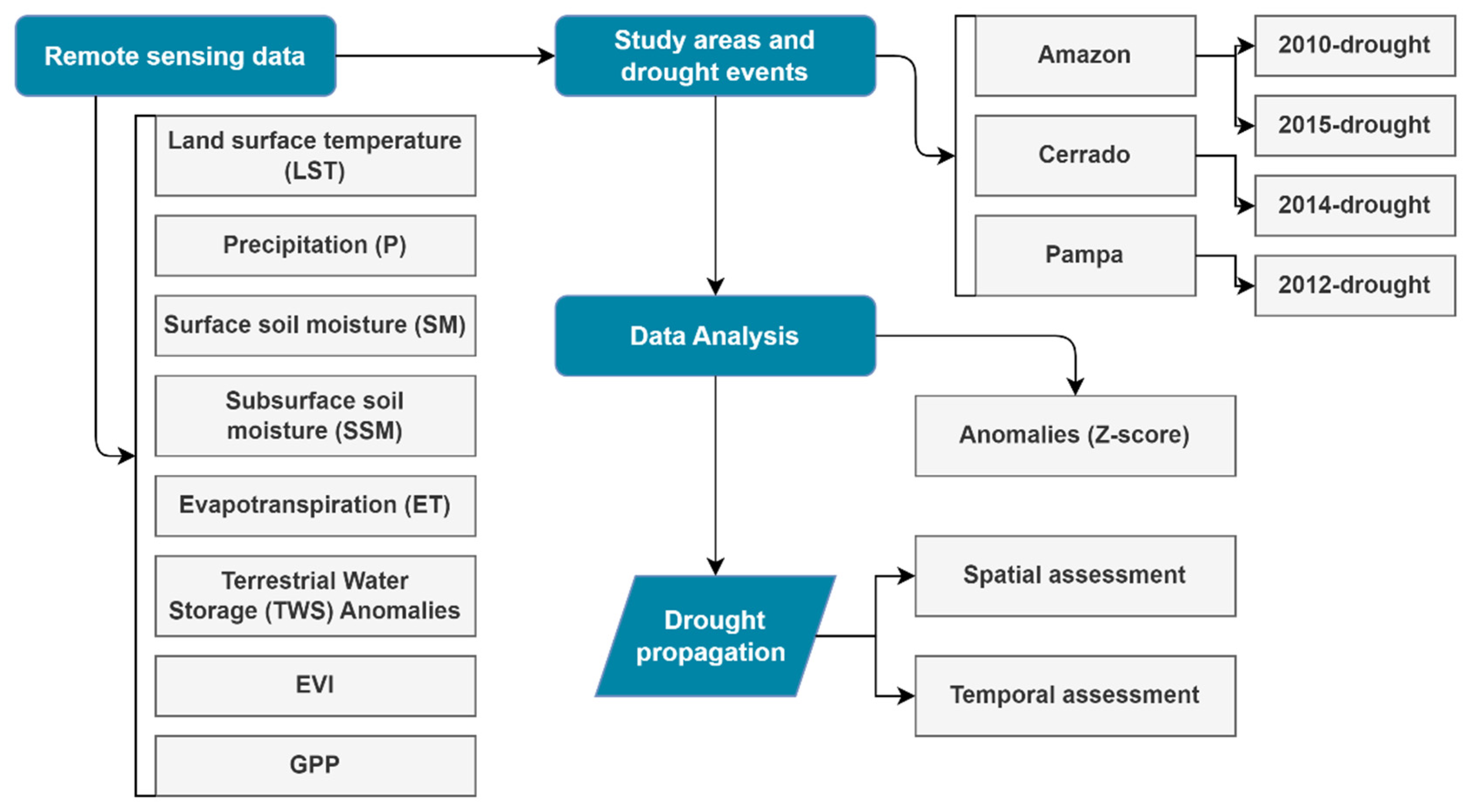
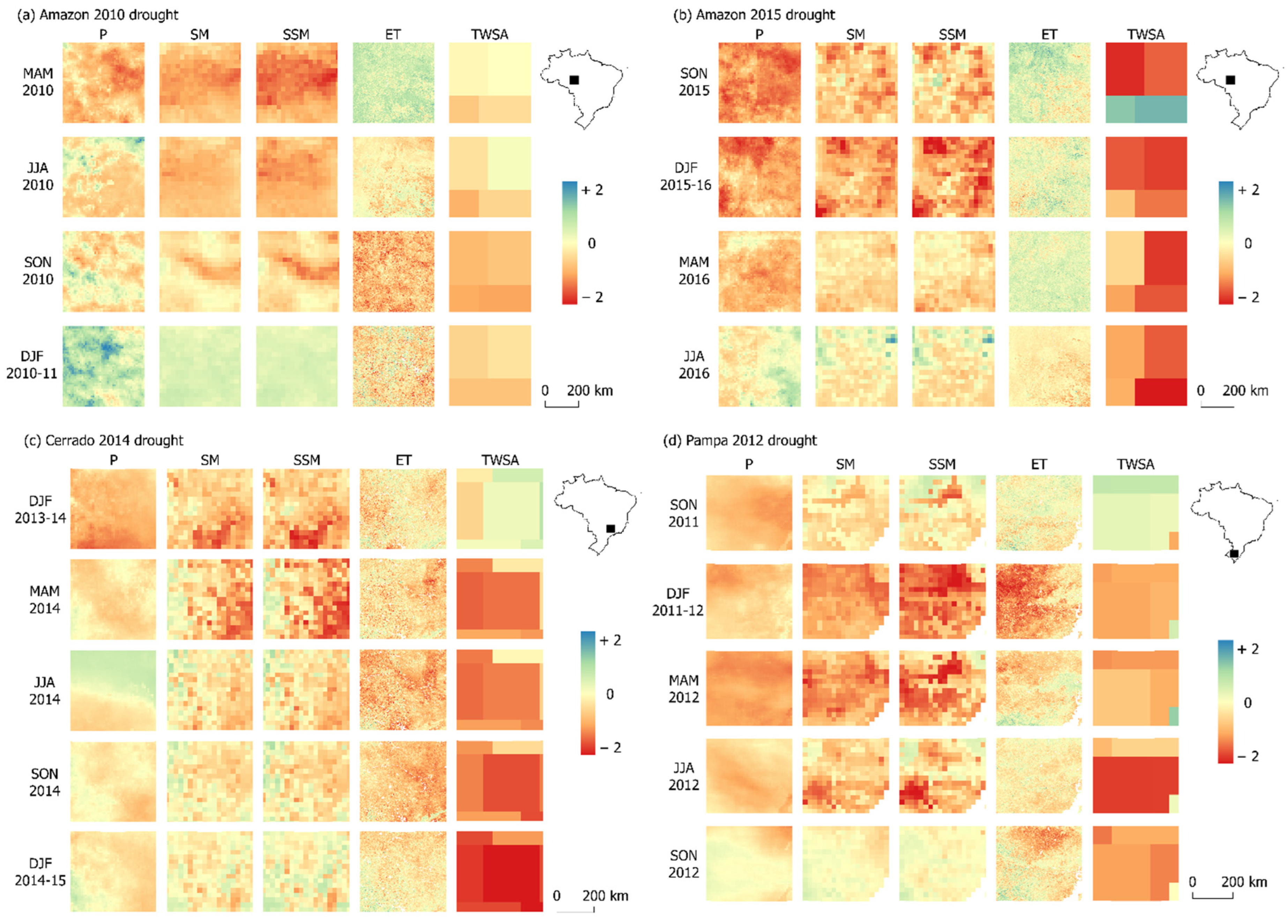
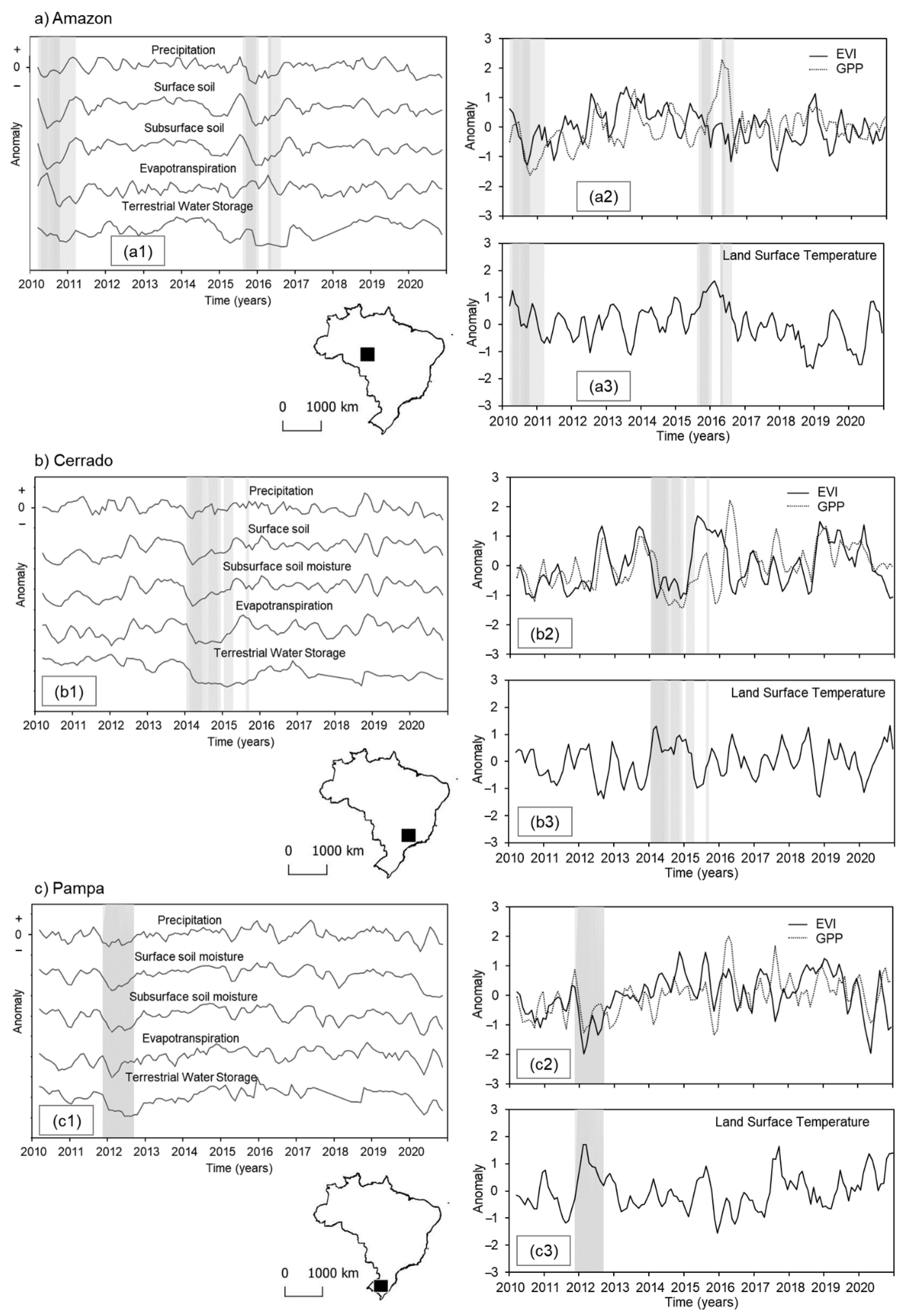
| Variable | Data | Spatial Resolution | Temporal Resolution | Data Availability | Main Reference |
|---|---|---|---|---|---|
| Land surface temperature (LST) | MOD11 | 1 km | 8 days | 2003–2016 | [63] |
| Precipitation (P) | IMERG | ~11 km | Monthly | 2003–2016 | [64] |
| Surface soil moisture (SM) | SMOS-SMAP | ~28 km | 3 days | 2010–2020 | [65] |
| Subsurface soil moisture (SSM) | |||||
| Evapotranspiration (ET) | MOD16 | 0.5 km | 8 days | 2003–2016 | [66] |
| Terrestrial Water Storage Anomalies (TWSA) | GRACE | ~111 km | Monthly | 2003–2016 | [67] |
| EVI | MOD13 | 1 km | 16 days | 2003–2016 | [68] |
| GPP | MOD17 | 0.5 km | 8 days | 2003–2016 | [69] |
| Location | Data | P | SM | SMM | ET | TWSA | |
|---|---|---|---|---|---|---|---|
| Amazon | 2010 | MAM | 24% | 39% | 65% | 0% | 0% |
| JJA | 0% | 5% | 32% | 2% | 0% | ||
| SON | 1% | 2% | 11% | 29% | 22% | ||
| 2010–2011 | DJF | 0% | 0% | 0% | 13% | 0% | |
| 2015 | JJA | 0% | 0% | 0% | 0% | 35% | |
| SON | 79% | 22% | 22% | 0% | 66% | ||
| 2015–2016 | DJF | 52% | 44% | 60% | 1% | 88% | |
| 2016 | MAM | 22% | 1% | 4% | 0% | 69% | |
| JJA | 0% | 0% | 0% | 1% | 88% | ||
| SON | 0% | 0% | 0% | 0% | 0% | ||
| Cerrado | 2013 | SON | 0% | 0% | 1% | 0% | 0% |
| 2013–2014 | DJF | 26% | 21% | 27% | 6% | 0% | |
| 2014 | MAM | 0% | 28% | 40% | 10% | 88% | |
| JJA | 0% | 3% | 7% | 29% | 88% | ||
| SON | 0% | 0% | 1% | 22% | 90% | ||
| 2014–2015 | DJF | 0% | 1% | 2% | 2% | 100% | |
| 2015 | MAM | 0% | 0% | 1% | 1% | 62% | |
| JJA | 0% | 2% | 2% | 0% | 62% | ||
| SON | 0% | 0% | 0% | 0% | 53% | ||
| 2015–2016 | DJF | 0% | 0% | 0% | 0% | 2% | |
| Pampa | 2011 | JJA | 0% | 0% | 0% | 1% | 0% |
| SON | 20% | 1% | 7% | 1% | 3% | ||
| 2011–2012 | DJF | 11% | 62% | 76% | 51% | 56% | |
| 2012 | MAM | 78% | 62% | 47% | 4% | 25% | |
| JJA | 3% | 20% | 28% | 0% | 73% | ||
| SON | 2% | 0% | 0% | 11% | 78% | ||
| 2012–2013 | DJF | 0% | 0% | 0% | 0% | 0% | |
| LST | P | SM | SSM | ET | TWSA | EVI | GPP | |
|---|---|---|---|---|---|---|---|---|
| Amazon 2010 drought | ||||||||
| Onset (month) | −1 | 0 | 1 | 1 | 4 | 5 | 3 | 4 |
| Duration (month) | 3 | 4 | 7 | 7 | 4 | 5 | 4 | 9 |
| Maximum intensity (z-score) | +1.5 | −1.3 | −2.1 | −2.1 | −1.8 | −1.8 | −2.0 | −1.9 |
| Amazon 2015 drought | ||||||||
| Onset (month) | 0 | 0 | 1 | 1 | 5 | 4 | 9 | 12 |
| Duration (month) | 10 | 5 | 4 | 4 | 1 | 7 | 3 | 2 |
| Maximum intensity (z-score) | +1.8 | −2.0 | −2.2 | −2.3 | −0.9 | −1.7 | −1.8 | −1.9 |
| Cerrado 2014 drought | ||||||||
| Onset (month) | 0 | 0 | 0 | 0 | 1 | 2 | 1 | 3 |
| Duration (month) | 3 | 3 | 6 | 7 | 11 | 15 | 2 | 10 |
| Maximum intensity (z-score) | +1.9 | −1.4 | −1.8 | −1.9 | −2.0 | −1.6 | −1.9 | −1.8 |
| Pampa 2012 drought | ||||||||
| Onset (month) | 1 | 0 | 1 | 1 | 1 | 1 | 1 | 1 |
| Duration (month) | 4 | 3 | 7 | 10 | 5 | 9 | 4 | 5 |
| Maximum intensity (z-score) | +2.1 | −1.6 | −1.9 | −1.8 | −2.1 | −1.9 | −2.2 | −1.4 |
Disclaimer/Publisher’s Note: The statements, opinions and data contained in all publications are solely those of the individual author(s) and contributor(s) and not of MDPI and/or the editor(s). MDPI and/or the editor(s) disclaim responsibility for any injury to people or property resulting from any ideas, methods, instructions or products referred to in the content. |
© 2023 by the authors. Licensee MDPI, Basel, Switzerland. This article is an open access article distributed under the terms and conditions of the Creative Commons Attribution (CC BY) license (https://creativecommons.org/licenses/by/4.0/).
Share and Cite
Rossi, J.B.; Ruhoff, A.; Fleischmann, A.S.; Laipelt, L. Drought Propagation in Brazilian Biomes Revealed by Remote Sensing. Remote Sens. 2023, 15, 454. https://doi.org/10.3390/rs15020454
Rossi JB, Ruhoff A, Fleischmann AS, Laipelt L. Drought Propagation in Brazilian Biomes Revealed by Remote Sensing. Remote Sensing. 2023; 15(2):454. https://doi.org/10.3390/rs15020454
Chicago/Turabian StyleRossi, Júlia Brusso, Anderson Ruhoff, Ayan Santos Fleischmann, and Leonardo Laipelt. 2023. "Drought Propagation in Brazilian Biomes Revealed by Remote Sensing" Remote Sensing 15, no. 2: 454. https://doi.org/10.3390/rs15020454
APA StyleRossi, J. B., Ruhoff, A., Fleischmann, A. S., & Laipelt, L. (2023). Drought Propagation in Brazilian Biomes Revealed by Remote Sensing. Remote Sensing, 15(2), 454. https://doi.org/10.3390/rs15020454





